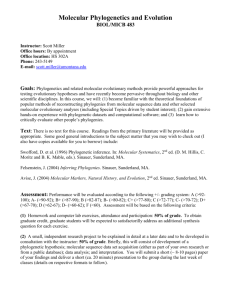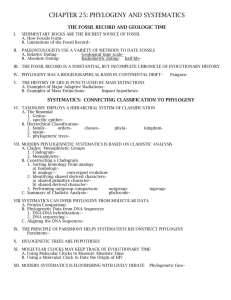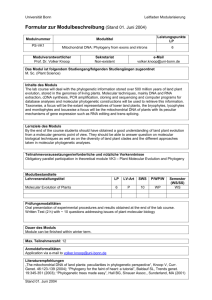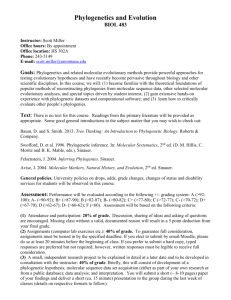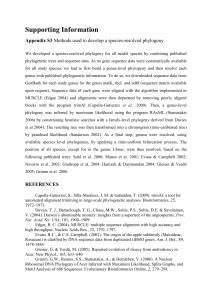doc
advertisement
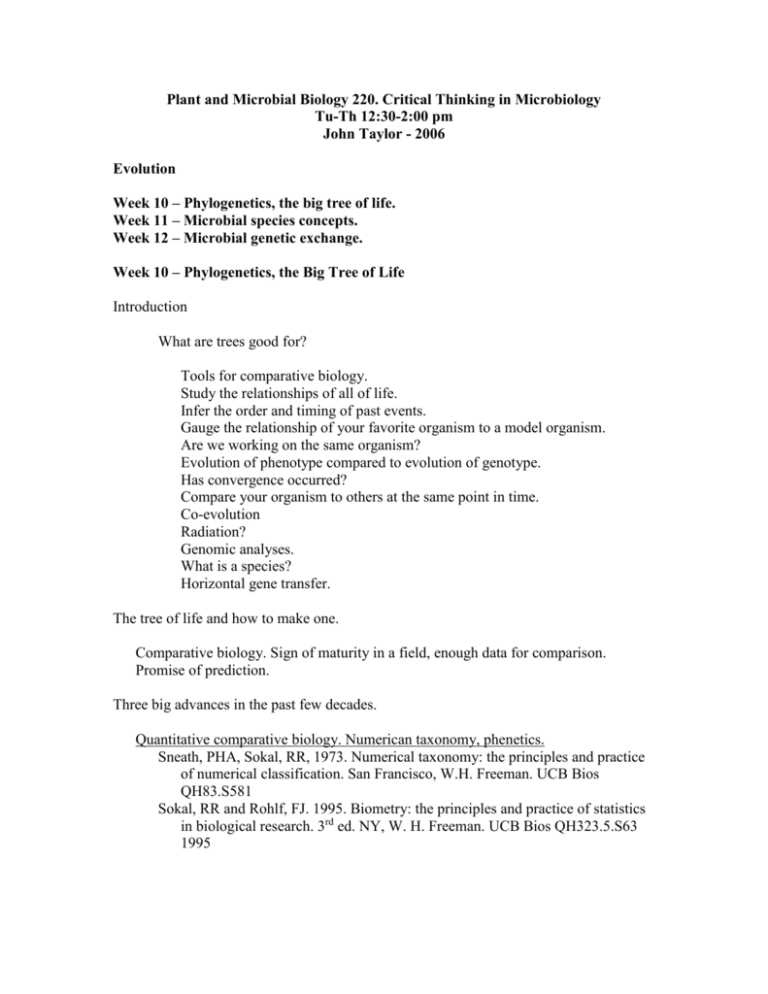
Plant and Microbial Biology 220. Critical Thinking in Microbiology Tu-Th 12:30-2:00 pm John Taylor - 2006 Evolution Week 10 – Phylogenetics, the big tree of life. Week 11 – Microbial species concepts. Week 12 – Microbial genetic exchange. Week 10 – Phylogenetics, the Big Tree of Life Introduction What are trees good for? Tools for comparative biology. Study the relationships of all of life. Infer the order and timing of past events. Gauge the relationship of your favorite organism to a model organism. Are we working on the same organism? Evolution of phenotype compared to evolution of genotype. Has convergence occurred? Compare your organism to others at the same point in time. Co-evolution Radiation? Genomic analyses. What is a species? Horizontal gene transfer. The tree of life and how to make one. Comparative biology. Sign of maturity in a field, enough data for comparison. Promise of prediction. Three big advances in the past few decades. Quantitative comparative biology. Numerican taxonomy, phenetics. Sneath, PHA, Sokal, RR, 1973. Numerical taxonomy: the principles and practice of numerical classification. San Francisco, W.H. Freeman. UCB Bios QH83.S581 Sokal, RR and Rohlf, FJ. 1995. Biometry: the principles and practice of statistics in biological research. 3rd ed. NY, W. H. Freeman. UCB Bios QH323.5.S63 1995 Spread of Hennig’s ideas on cladistics. Hennig, W. 1950. Grundzuge einer Theorie der phylogenetischen Systematik. Berlin, Deutscher zentralverlag. UCB Bios QL351.H4 Hennig, W. 1966. Phylogenetic systematics. Translated by D. D. Davis and Rainer Zangerl. Urbana, U. Illinois Press. UCB Bios QL351.H413, also a 1979 edition with same call number. Access to nucleic acid variability. Phenotypic characters and genotypic characters. Key assumption, homology of characters. Homology, paralogy Secondary assumption, independence of characters. TAXA, organisms or genes. Types of phylogenetic methods Methods currently in practice: Genearal Avise, J. C. 1994. Molecular markers, natural history and evolution. Chapman and Hall, New York. Felsenstein, Joseph. 2004. Inferring phylogenies. Sunderland, Mass.: Sinauer Associates. Bioscience QH83.F45 2004. Moffitt QH83.F45 2004 Page, R. D. M. (ed.). 2003. Tangled trees : phylogeny, cospeciation, and coevolution. Chicago, Ill. : The University of Chicago Press. Bioscience QH367.5.T36 2003 Page, R. D. M. and E. C. Holmes. 1998. Molecular evolution : a phylogenetic approach. Oxford ; Malden, MA : Blackwell Science. Bioscience QH390.P34 1998 How to Hillis, D. M., C. Moritz, and B. K. Mable. 1996. Molecular Systematics. Sinauer Associates, Sunderland, Mass. Li, W.-H. 1997. Molecular Evolution. Sinauer Associates. UCB Bios QH325.L655 1997 Hoch, PC, Stephenson, AG. 1995. Experimental and molecular approaches to plant biosystematics. St. Louis, Missouri Bot. Garden UCB Bios QK95.E96 1995 Salemi, M. and Vandamme, A.-M.. 2003. The phylogenetic handbook : a practical approach to DNA and protein phylogeny. Cambridge U Press. Maddison, W. P., and D. R. Maddison. 2000. MacClade: analysis of phylogeny and character evolution, version 4. Sinauer Associates, Sunderland, Mass. Hall, Barry G. 2004. Phylogenetic trees made easy: a how-to manual, 2nd ed. Sinauer, Sunderland, Mass. : Sinauer Associates. Bioscience QH367.5.H27 2004 Bayesian Huelsenbeck, J. P., F. Ronquist, R. Nielsen, and J. P. Bollback. 2001. Evolution Bayesian inference of phylogeny and its impact on evolutionary biology. Science V294:2310-2314. Huelsenbeck, J.P., Larget, B., Miller, R.E., Ronquist, F. 2002. Potential Applications and Pitfalls of Bayesian Inference of Phylogeny. Syst. Biol. 51:673-688. Lewis, P.O. 2001. Phylogenetic systematics turns over a new leaf. TREE 16:30-37. Holder, M. and P. O. Lewis. 2003. "Phylogeny estimation: Traditional and Bayesian approaches." Nature Reviews Genetics 4(4): 275-284 Phylogenetic Approach Problem, Define it. Select likely data Collect data from a subset of your taxa. Blast, Entrez-Taxonomy, NCBI, Google entrez. ABI sequencer. Determine homology ClustalW, ClustalX alignment (google clustal) Your brain Analyze data phylogenetically UC Museum of Paleontology http://www.ucmp.berkeley.edu/subway/phylo/phylosoft.html Joe Felsenstein at the University of Washington http://evolution.genetics.washington.edu/phylip/software.html Distance methods UPGMA, Fitch Margoliash, Neighbor-Joining Multiple hit corrections Jukes/Cantor, Kimura, etc. Character based methods Parsimony Maximum Likelihood, Model Test (http://darwin.uvigo.es/software/modeltest.html), Posada D and Crandall KA 1998. Modeltest: testing the model of DNA substitution. Bioinformatics 14 (9): 817-818 Bayesian methods, likelihood with probabilities Assess significance Bremmer/Decay index Bootstrap resampling Bayesian posterior probability If the result is not significant, go back to selecting new data. If the result is significant, obtain data for all taxa and go back to analysis. If the result is significant, but is not in agreement (congruent) with hypotheses based on other data, test for significance of incongruence. Tests of congruence Kishino-Hasegawa Test Shimodaira-Hasagawa Test Incongruity Length Difference/Partition homogeneity test If the two hypotheses are significantly incongruent, reexamine both data sets. One can be wrong, the other can be wrong, both can be wrong, but both cannot be right. Pitfalls of Phylogenetics Not enough taxa (two taxon trees). Wakefield, A. E., S. E. Peters, S. Banerji, P. D. Bridge, G. S. Hall, D. L. Hawksworth, L. A. Guuiver, A. G. Allen, and J. M. Hopkin. 1992. Pneumocystis carinii shows DNA homology with the ustomycetous red yeast fungi. Molecular Microbiology 6:1903-1911 Taylor, J. W., and B. H. Bowman. 1993. Pneumocystis carinii and the ustomycetous red yeast fungi. Molecular Microbiology 8:425-426. The homoplasy proof “super character” Morden, C. W., and S. S. Golden. 1989. psbA genes indicate common ancestry of prochlorophytes and chloroplasts. Nature 337:382-385. Morden, C. W., and S. S. Golden. 1991. Sequence analysis and phylogenetic reconstruction of the genes encoding the large and small subunits of ribulose-1,5-bisphosphate carboxylase/oxygenase from the chlorophyll bcontaining prokaryote Prochlorothrix hollandica. J. Mol. Evol. 32:379-395. Shimada, A., S. Kanai, and T. Maruyama. 1995. Partial sequence of ribulose-1,5bisphosphate carboxylase-oxygenase and the phylogeny of Prochloron and Prochlorococcus (Prochlorales). Journal of Molecular Evolution 40:671677. Rooting Lewis, M. T., and J. F. Feldman. 1996. Evolution of the frequency (frq) clock locus in ascomycete fungi. Mol. Biol. Evol. 13:1233-1241. Background for today’s material Baldauf, ,S. L. (2003). Phylogeny for the faint of heart: a tutorial. Trends in Genetics 19, 345-351 Berbee, M., and J. W. Taylor. 1999. Fungal Phylogeny. Pp. 12-77 in R. P. Oliver and N. N. Schweizer, eds. Molecular Fungal Biology. Cambridge University Press, Cambridge. Lewis, P.O. 2001. Phylogenetic systematics turns over a new leaf. TREE 16:30-37 (Bayesian methods). Walsh, D. A. and W. F. Doolittle. 2005. The real 'domains' of life. Current Biology 15:R237-R240. Reading for Thursday: Brown, J. R. and W. F. Doolittle (1997). "Archaea and the prokaryote-to-eukaryote transition." Microbiology and Molecular Biology Reviews 61(4): 456-502. Jeffroy, O., Brinkmann, H., Delsuc, F. & Philippe, H. (2006). Phylogenomics: the beginning of incongruence? Trends in Genetics 22, 225-231 Rokas, A., B. L. Williams, N. King and S. B. Carroll (2003). "Genome-scale approaches to resolving incongruence in molecular phylogenies." Nature 425(6960): 798-804.
